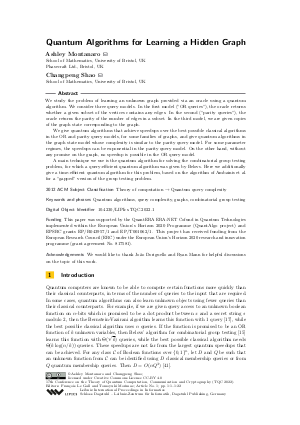@InProceedings{montanaro_et_al:LIPIcs.TQC.2022.1,
author = {Montanaro, Ashley and Shao, Changpeng},
title = {{Quantum Algorithms for Learning a Hidden Graph}},
booktitle = {17th Conference on the Theory of Quantum Computation, Communication and Cryptography (TQC 2022)},
pages = {1:1--1:22},
series = {Leibniz International Proceedings in Informatics (LIPIcs)},
ISBN = {978-3-95977-237-2},
ISSN = {1868-8969},
year = {2022},
volume = {232},
editor = {Le Gall, Fran\c{c}ois and Morimae, Tomoyuki},
publisher = {Schloss Dagstuhl -- Leibniz-Zentrum f{\"u}r Informatik},
address = {Dagstuhl, Germany},
URL = {https://drops.dagstuhl.de/entities/document/10.4230/LIPIcs.TQC.2022.1},
URN = {urn:nbn:de:0030-drops-165081},
doi = {10.4230/LIPIcs.TQC.2022.1},
annote = {Keywords: Quantum algorithms, query complexity, graphs, combinatorial group testing}
}

 Creative Commons Attribution 4.0 International license
Creative Commons Attribution 4.0 International license














